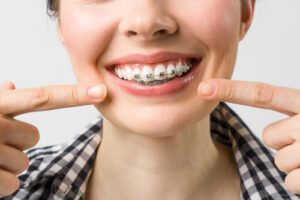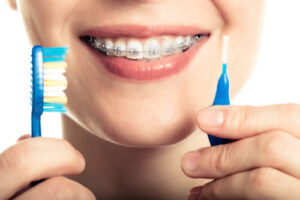Table of Contents
The removal of braces is often marked by a celebratory reveal, a moment where years of patience and diligent care culminate in unveiling a straighter, more confident smile. However, for some individuals, this moment of triumph can be tempered by an unexpected development: flared teeth after braces are removed. While not universally experienced, this post-orthodontic concern presents a unique set of questions and a quest for solutions within the dental community.
In the forthcoming article, we will carefully dissect the causes and implications of this dental phenomenon, offering a glimpse into the nuanced understanding that dental professionals hold on the matter. Without revealing too much too soon, we invite you to join us on a deep dive into the world of the teeth’ normal post-braces dental dynamics, where we will investigate the subtleties of flared teeth and the sophisticated approaches to managing them, ensuring that the path to a perfect smile remains clear and navigable.
What are the signs of flared teeth
The revelation of flared teeth can be a disturbing epilogue to the orthodontic narrative, one that is not always anticipated but is unmistakable in its presentation. As we embark on a detailed exploration of this condition, it is crucial to identify the hallmarks that signify the divergence from the intended orthodontic outcome. Here, we delineate the signs with precision and clarity:
- Altered Dental Alignment: The front teeth, especially the incisors, may angle outward noticeably, betraying the straight line they once formed.
- Gaps and Spacing Issues: New spaces between teeth may emerge, a stark contrast to the uniformity braces aim to achieve.
- Bite Discrepancy: The way teeth come together can change, potentially leading to an open bite where front teeth no longer meet their counterparts.
- Lip Posture Changes: A subtle but telling sign where the lips struggle to close naturally over teeth that now protrude.
- Functional Challenges: Difficulties may arise in speech or chewing, as the teeth’ new positions can affect oral functions.
In conclusion, these signs are not just cosmetic concerns but can have functional implications that warrant professional attention. Understanding these symptoms is the first step in addressing the condition and restoring the aesthetics of buck teeth and the harmony of a healthy smile. As we navigate the complexities of flared teeth, it is essential to approach the subject with a blend of clinical insight and empathetic care, ensuring that the path to resolution is as informed as it is compassionate.
Is it normal for your teeth to look weird after braces?
It is not uncommon for teeth to appear somewhat unusual immediately following the removal of braces, a period often marked by adjustment. The new positioning of your teeth, free from the brackets and wires, can seem strange as you acclimate to the change. Additionally, slight discoloration or differences in enamel texture where the braces were bonded may be visible, though these are typically temporary and can be addressed with professional dental care.
It’s also important to note that gums and bones need time to adapt to the new tooth alignment, which can temporarily affect the smile’s appearance. However, any pronounced or persistent irregularities should be evaluated by an orthodontist to ensure that all your teeth’ post-braces transition is progressing as expected.
Causes of flared teeth after braces removed

The attainment of straight teeth through braces is a significant milestone in orthodontic treatment, yet the emergence of flared teeth after braces are removed can be a concern for many patients. This dental phenomenon, where the front teeth angle outward, can stem from a variety of causes:
- Insufficient Retention: Post-braces, wearing retainers is crucial to maintain the new teeth positions. Inadequate use of fixed or removable retainers can lead to teeth flaring.
- Natural Tooth Movement: Even after braces treatment, teeth naturally shift, which can result in a flared appearance if not properly managed with a retainer.
- Orthodontic Technique: The specific braces treatment method, including the type of orthodontic appliance used, can influence whether flared teeth happen. For instance, certain techniques like four bicuspid extractions can create more room, potentially leading to flared teeth if not compensated for with proper orthodontic work.
- Oral Habits: Bad habits such as tongue thrusting or the prolonged use of hard objects can exert pressure on the teeth, causing them to flare after braces are removed.
- Anatomical Factors: Patients with smaller than average jaws or a narrow arch may experience flared teeth due to insufficient room to accommodate all the teeth in proper alignment.
- Wisdom Teeth Eruption: The pressure from emerging wisdom teeth can sometimes cause tooth movement, leading to flared front teeth.
A professional orthodontist can assess these factors and determine the best treatment option to correct flared teeth, including wearing retainers or other orthodontic appliances. Following the orthodontic professional’s guidance and having your retainer properly adjusted to prevent teeth from moving out of their desired position is essential. Ultimately, the goal is to ensure a healthy smile and maintain the beautiful results achieved through braces, permanent retainers, bolstering oral health and self-confidence.
How to treat flared teeth after braces removed
Flared teeth after the removal of braces can compromise the aesthetic and functional results achieved by orthodontic treatment. It is crucial to address this issue promptly to maintain a healthy smile and prevent further dental complications. Here are the points to consider for treating flared teeth post-braces:
Treatment Options:
- Fixed Retainers: These are bonded behind the front teeth, preventing teeth from returning to their previous protruding position.
- Removable Retainers: Clear or acrylic retainers can be custom-made, ensuring teeth remain in their new positions.
- Orthodontic Adjustments: Minor adjustments with other orthodontic appliances may be necessary to correct flared teeth.
- Wearing Retainers Properly: Consistent wear is critical, especially immediately after removing braces.
- Monitoring Tooth Movement: Regular check-ups with an orthodontist to monitor tooth movement and retainer fit.
- Addressing Underlying Issues: Early intervention to manage factors like wisdom teeth emergence that may cause a shift in tooth alignment.
Retention is a vital phase of orthodontic work, as crucial as the braces treatment. Consulting with a professional orthodontist is imperative to treat flared teeth effectively and ensure a long-lasting, beautiful smile. Following the orthodontic professional’s advice on retainer use and oral hygiene, most patients can prevent the recurrence of flared teeth and maintain a straight, healthy smile.
How long does it take to fix flared teeth after braces are removed?
The duration required to correct flared teeth after braces removal varies depending on the severity of the case. Generally, it can take several months to a year for teeth to fully settle into their new positions. However, individual results may differ, and it’s essential to follow post-brace instructions diligently, including wearing retainers as prescribed by the orthodontist.
Regular check-ups will also be necessary to monitor progress and make necessary adjustments. Compliance with recommended oral hygiene practices and maintenance routines is crucial in achieving optimal and lasting results.
How to prevent flared teeth after braces

To maintain the corrected alignment achieved through orthodontic treatment and prevent flared teeth after braces, a combination of consistent retainer wear, good oral hygiene practices, and collaboration with an experienced orthodontic professional is essential.
- Retainer Consistency: Whether fixed or removable, retainers prevent flared teeth. Fixed retainers, typically thin wires bonded to the back of the front teeth, provide continuous stabilization. Removable options, such as clear plastic or acrylic retainers, should be worn according to the orthodontist’s instructions, especially during nighttime.
- Clear Aligners: Consider clear aligners, like Invisalign, as an alternative to traditional braces for maintaining corrected tooth positions. Consult with your orthodontic professional to determine the most suitable retainer type and wear schedule based on your specific orthodontic needs.
- Oral Hygiene Practices: Practicing good oral hygiene, including regular brushing, flossing, and dental check-ups, is vital to prevent any relapse in tooth alignment. This reduces the risk of orthodontic problems and contributes to overall oral health.
- Early Intervention: In some cases, orthodontic appliances other than braces may be recommended. Early intervention by a professional orthodontist can address potential issues before they escalate, ensuring a smoother orthodontic journey.
Preventing and correcting flared teeth even after braces involves a holistic approach, encompassing diligent retainer use, exemplary oral hygiene practices, and ongoing collaboration with an experienced orthodontic professional. By following these guidelines, individuals can maintain a lasting, straight, and healthy smile.
When to seek medical attention
Knowing when to seek medical attention for flared teeth after removing braces is crucial for maintaining optimal oral health and addressing any potential issues promptly. While orthodontic treatment aims to correct tooth alignment, factors such as relapse or unexpected complications may arise. Understanding the signs that warrant medical attention is essential for ensuring the success of the orthodontic journey.
- Visible Flaring or Protrusion: If there is noticeable flaring or protrusion of the front teeth after removing braces, it is advisable to seek prompt medical attention. This could indicate a relapse in tooth alignment that requires evaluation and corrective measures.
- Discomfort or Pain: Persistent discomfort or pain around the teeth, especially after removing braces, should not be ignored. It may signify underlying issues that need assessment by an orthodontic professional to ensure the stability of the corrected alignment.
- Changes in Bite: Any significant changes in your bite, such as difficulty in closing your teeth together or an uneven bite, should prompt a visit to an orthodontic office. These changes could indicate shifting or movement of the teeth that may need to be addressed.
- Issues with Retainers: If there are problems with the retainers, whether they are fixed or removable, such as breakage, looseness, or discomfort while wearing them, it is important to consult with an orthodontist. Adjustments or replacements may be necessary to maintain the corrected alignment.
- Persistent Orthodontic Problems: If you experience persistent orthodontic problems, even after braces have been removed, such as the recurrence of crooked teeth or flaring, seeking the expertise of an orthodontic professional is crucial. They can assess the situation and recommend appropriate measures to address the issues.
In conclusion, seeking medical attention for flared teeth after braces and wearing retainers is essential when there are visible signs of relapse, discomfort, changes in bite, issues with retainers, or persistent orthodontic problems. Early intervention by an orthodontic professional ensures that any issues are addressed promptly, maintaining the success of the orthodontic treatment and preserving a straight and healthy smile.
Conclusion
In conclusion, managing flared teeth after braces are removed is critical in preserving the beautiful smile you’ve worked hard to achieve. It’s not uncommon to experience some degree of teeth flaring once the structural support of braces is gone, but with the right approach, these issues can be effectively addressed. By adhering to the post-treatment care plan outlined by your orthodontist, using retainers as directed, and maintaining excellent oral hygiene, you can enjoy the long-term benefits of your orthodontic treatment. Remember, the journey to a perfect smile doesn’t end with braces; it’s a lifelong commitment to oral health and wellness. Keep your smile shining bright by giving it the care it deserves, especially if you’ve experienced flared teeth after braces removal.
References
Endodontic Flare-Up
http://endodontics.styleitaliano.org/endodontic-flare-up/
Evaluation of Safety Concerns for Certain Dental Devices Used in Adults: FDA Safety Communication
https://www.fda.gov/medical-devices/safety-communications/evaluation-safety-concerns-certain-dental-devices-used-adults-fda-safety-communication
Clinical and Radiographic Evaluation of Flare-ups in Endodontics: A Cross-sectional Study
https://pubmed.ncbi.nlm.nih.gov/37635454/
A Comparative Evaluation of Flare-ups During Root Canal Treatment with Two Nickel-Titanium Rotary Instruments
https://onlinelibrary.wiley.com/doi/abs/10.1111/j.1708-8240.2006.00060.x
